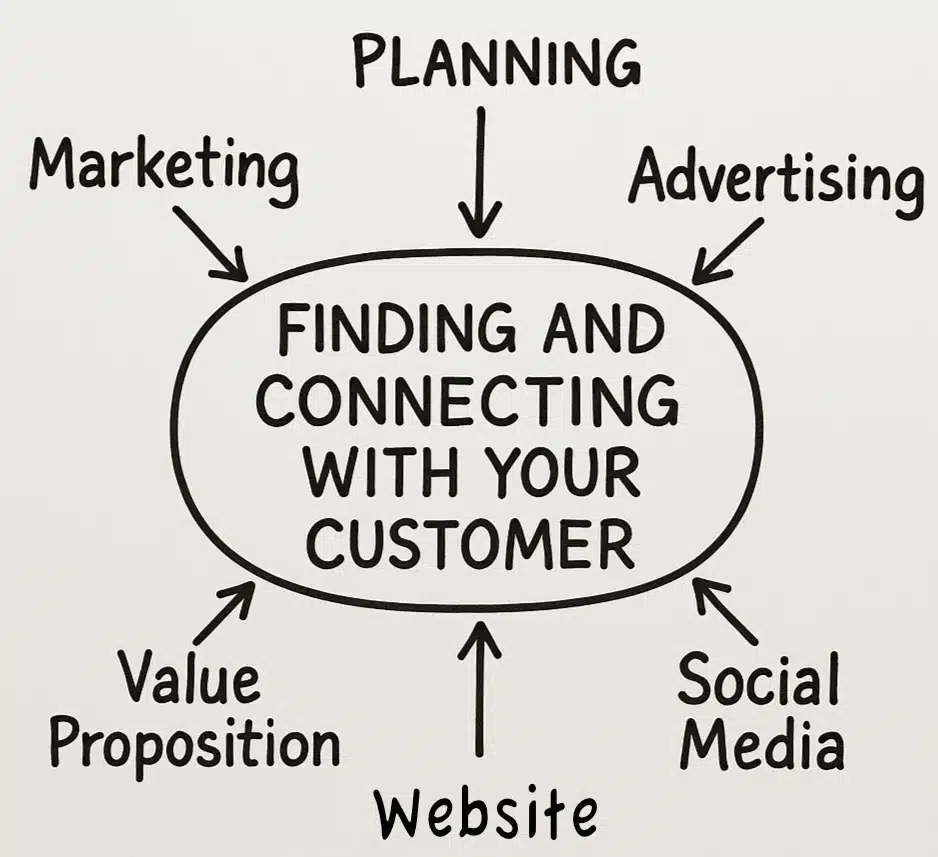The Key to Starting a Successful Business (What to Actually Obsess Over)
Updated on November 7, 2025 by Tim Donahue
It’s the only thing that matters – more than your logo, your website, or your “big idea.”
Most beginners get this wrong. They obsess over the shiny stuff—logos, color palettes, websites, even business cards (yes, people still waste time on those).
It won’t.
A pretty logo without paying customers is just graphic design.
A clever website without buyers is just digital clutter.
And a business card without sales is just a sad little rectangle.
Here’s the blunt truth: if you don’t know your market, you don’t have a business. You have a hobby.

Know Your Market First: The Key to Starting a Successful Business
Here’s What You Actually Need to Obsess Over
- Who exactly are you selling to? Be specific. “People who like coffee” is garbage. “Remote workers in their 30s who drink iced lattes at 2 p.m. because they’re tired of Zoom” — now you’re getting somewhere.
- What problem are you solving that they feel in their bones? If they’re not wincing when they describe it, you’re too far from the pain.
- Where do they already spend money, and why would they switch to you? If you can’t answer that without lying to yourself, you need to rethink.
- How will you connect with your market? They’re out there, but you need a realistic strategy to find and reach them. Hint: “ads” or “social media” are surface-level answers. The real work is understanding them so deeply that you can choose the channels, timing, and message that actually reach them—without sinking yourself.
Once you nail those four, everything else falls into place.
- Marketing stops feeling like begging.
- Sales stop feeling like trickery.
- You stop being a founder screaming into the void, and you start being the solution people are actually looking for.
The rookies will always obsess over fonts, taglines, and hashtags. The pros obsess over finding their first customers—what they need, where they hang out, and how to connect with them so strongly that handing you money feels obvious.
And that, my friend, is the only obsession worth having when you’re starting your new business.
For a structured way to research your market and competitors, see the SBA’s guide to market research and competitive analysis.
Practical Steps to Start a Successful Business Today:
The Actionable Simple Steps To Take Now
You don’t need a five-year plan. You don’t need an MBA. You don’t even need a fancy desk setup. You just need to take a few smart, doable steps that get you moving toward your first real customer. Here’s how:
- Write down your offer in one sentence. If you can’t explain what you’re selling and who it’s for in 15 words or less, you don’t understand it yet.
- Make a list of 10 people who fit your target market. Not “the world.” Not “everybody on Instagram.” Ten real humans who might actually buy.
- Talk to them. Not surveys. Not a Google Form. Actual conversations. Ask what they struggle with, how they currently solve it, and what they wish existed instead.
- Tweak your offer. Based on what you hear, sharpen your message so it speaks directly to their problem. (Hint: if you use their own words back at them, it’ll feel like you’re reading their mind.)
- Get your first yes. Don’t wait until you’ve perfected everything. Offer your service or product right away—even if it’s messy. That first paying customer is worth more than a hundred “likes.”
- Document what works. When something lands—a phrase, a pitch, a response—write it down. These are the seeds of your marketing strategy.
- Ignore the noise. Fancy tools, ads, and hashtags can come later. Right now, your only job is to find one person who wants what you’re offering, and help them.
- Figure out where you’ll be able to find and connect with your customers – those whose problem you are solving.
Where Your First Customers Are (and How to Reach Them)
Knowing your customer isn’t enough. You need to know where they are and how to reach them. Here’s a simple way to break it down:
- Map their daily life. Think about where they spend their time—online and offline. Do they scroll LinkedIn at work? Hang out in Facebook parenting groups? Shop at local markets? Make a list.
- Find their trusted sources. Where do they get advice? Which podcasts, YouTube channels, newsletters, or community leaders influence them? If you can show up in those spaces, you borrow their trust.
- Look for natural intersections. Where do their problems and your solutions overlap in real life? For example: if you solve meal planning, they’re probably already in grocery store apps, recipe blogs, or TikTok cooking videos.
- Choose connection strategies beyond “just ads.” Ads and social media are tools, but not strategies. Real strategies could be: joining niche groups, running targeted workshops, offering free resources where your audience already is, or building partnerships with people they trust.
- Test, measure, adjust. Start with one or two channels. Track if people respond. Double down on what works; drop what doesn’t. Don’t spread yourself thin trying to be everywhere.
The goal is simple: meet them where they already are, speak their language, and make connecting with you feel natural—not forced. Once you master this, you won’t be chasing customers… they’ll be finding you.
Where Can I Look for My Customers?
Here are 10 practical places to start looking for your customers—both online and offline:
Online
- Facebook or LinkedIn Groups: Communities around hobbies, industries, or problems (e.g. “Freelance Designers Collective,” “Parents of Teens with ADHD”).
- Reddit Threads & Niche Forums: Subreddits or old-school forums where people actively ask questions and vent frustrations.
- YouTube Comments & Channels: See what people are watching and asking under videos in your niche.
- Amazon or Yelp Reviews: Customers often spell out exactly what they love or hate about existing products/services.
- Hashtag Communities on Instagram/TikTok/X: Search hashtags tied to your problem/solution to find people already posting about it.
- Use the Census Business Builder to pull local demographics and industry data before you choose channels.
Offline
- Local Meetups & Events: Meetup.com, chamber of commerce mixers, or networking nights where your target crowd naturally shows up.
- Conferences, Trade Shows, or Fairs: Industry-specific or lifestyle events where your target market gathers en masse.
- Coffee Shops, Gyms, Co-working Spaces: Everyday hangouts where you can strike up real conversations (great for service-based small businesses).
- Bulletin Boards & Community Centers: Still surprisingly effective for certain demographics (think dog walkers, tutors, local services).
- Retail Stores & Aisle Behavior: Watch how people shop in stores that serve your market—you’ll see real-time buying decisions.
Remember: The key isn’t just where you look—it’s what you listen for. Pay attention to the words, frustrations, and desires people naturally use. That’s your blueprint for how to connect with them.
Take these steps seriously, and by tonight you’ll be further ahead buidling your successful business than most people who spend months “planning” their new business without ever testing it in the real world.
